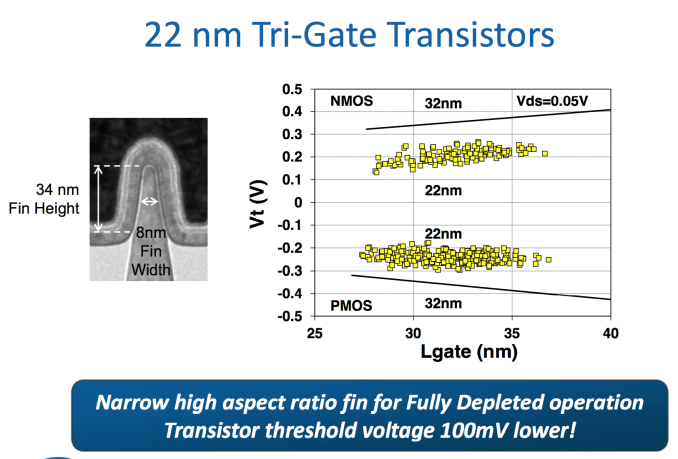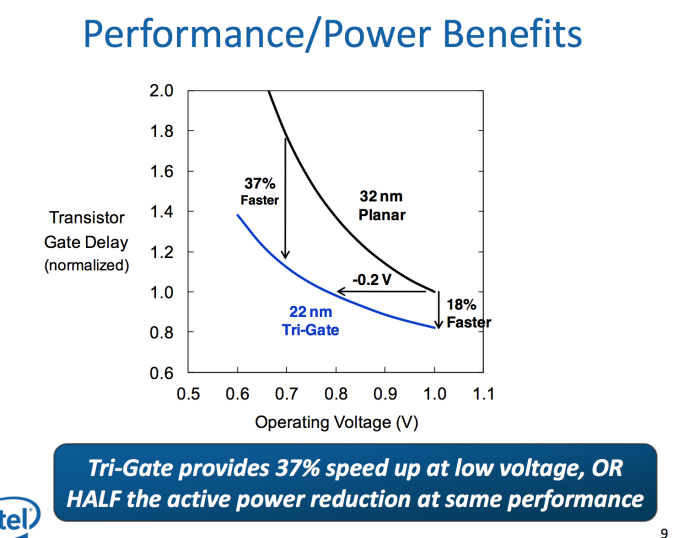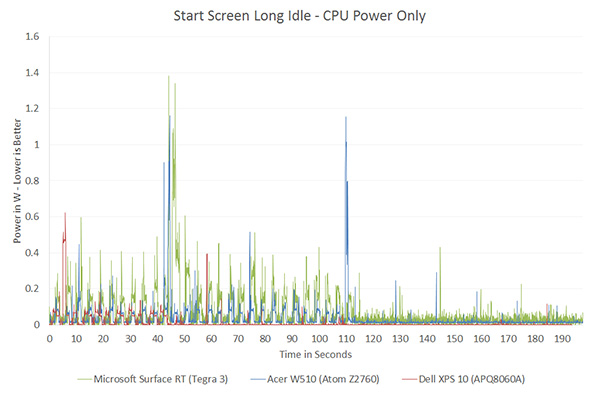Intel’s Silvermont Architecture Revealed: Getting Serious About Mobile
by Anand Lal Shimpi on May 6, 2013 1:00 PM EST- Posted in
- CPUs
- Intel
- Silvermont
- SoCs

The most frustrating part about covering Intel’s journey into mobile over the past five years is just how long it’s taken to get here. The CPU cores used in Medfield, Clover Trail and Clover Trail+ are very similar to what Intel had with the first Atom in 2008. Obviously we’re dealing with higher levels of integration and tweaks for further power consumption, but the architecture and much of the core remains unchanged. Just consider what that means. A single Bonnell core, designed in 2004, released in 2008, is already faster than ARM’s Cortex A9. Intel had this architecture for five years now and from the market’s perspective, did absolutely nothing with it. You could argue that the part wasn’t really ready until Intel had its 32nm process, so perhaps we’ve only wasted 3 years (Intel debuted its 32nm process in 2010). It’s beyond frustrating to think about just how competitive Intel would have been had it aggressively pursued this market.
Today Intel is in a different position. After acquisitions, new hires and some significant internal organizational changes, Intel seems to finally have the foundation to iterate and innovate in mobile. Although Bonnell (the first Atom core) was the beginning of Intel’s journey into mobile, it’s Silvermont - Intel’s first new Atom microarchitecture since 2008 - that finally puts Intel on the right course.
Although Silvermont can find its way into everything from cars to servers, the architecture is primarily optimized for use in smartphones and then in tablets, in that order. This is a significant departure from the previous Bonnell core that was first designed to serve the now defunct Mobile Internet Devices category that Intel put so much faith in back in the early to mid 2000s. As Intel’s first Atom architecture designed for mobile, expectations are high for Silvermont. While we’ll have to wait until the end of the year to see Silvermont in tablets (and early next year for phones), the good news for Intel is that Silvermont seems competitive right out of the gate. The even better news is that Silvermont will only be with us for a year before it gets its first update: Airmont.
 Intel made this announcement last year, but Silvermont is the beginning of Intel’s tick-tock cadence for Atom. Intel plans on revving Atom yearly for at least the next three years. Silvermont introduces a new architecture, while Airmont will take that architecture and bring it down to 14nm in 2014/2015. One year later, we’ll see another brand new architecture take the stage also on 14nm. This is a shift that Intel needed to implement years ago, but it’s still not too late.
Intel made this announcement last year, but Silvermont is the beginning of Intel’s tick-tock cadence for Atom. Intel plans on revving Atom yearly for at least the next three years. Silvermont introduces a new architecture, while Airmont will take that architecture and bring it down to 14nm in 2014/2015. One year later, we’ll see another brand new architecture take the stage also on 14nm. This is a shift that Intel needed to implement years ago, but it’s still not too late.
Before we get into an architectural analysis of Silvermont, it’s important to get some codenames in order. Bonnell was the name of the original 45nm Atom core, it was later shrunk to 32nm and called Saltwell when it arrived in smartphones and tablets last year. Silvermont is the name of the CPU core alone, but when it shows up in tablets later this year it will do so as a part of the Baytrail SoC and a part of the Merrifield SoC next year in smartphones.
22nm
To really understand the Silvermont story, you need to first understand Intel’s 22nm SoC process. Two years ago Intel announced its 22nm tri-gate 3D transistors, which would eventually ship a year later in Intel’s Ivy Bridge processors. That process wasn’t suited for ultra mobile. It was optimized for the sort of high performance silicon that was deployed on it, but not the ultra compact, very affordable, low power silicon necessary in smartphones and tablets. A derivative of that process would be needed for mobile. Intel now makes two versions of all of its processes, one optimized for its high performance CPUs and one for low power SoCs. P1270 was the 22nm CPU process, and P1271 is the low power SoC version. Silvermont uses P1271. The high level characteristics are the same however. Intel’s 22nm process moves to tri-gate non-planar transistors that can significantly increase transistor performance and/or decrease power.
This part is huge. The move to 22nm 3D transistors lets Intel drop threshold voltage by approximately 100mV at the same leakage level. Remember that power scales with the square of voltage, so a 100mV savings depending on what voltage you’re talking about can be very huge. Intel’s numbers put the power savings at anywhere from 25 - 35% at threshold voltage. The gains don’t stop there either. At 1V, Intel’s 22nm process gives it an 18% improvement in transistor performance or at the same performance Intel can run the transistors at 0.8V - a 20% power savings. The benefits are even more pronounced at lower voltages: 37% faster performance at 0.7V or less than half the active power at the same performance.
The end result here is Intel can scale frequency and/or add more active logic without drawing any more power than it did at 32nm. This helps at the top end with performance, but the vast majority of the time mobile devices are operating at very lower performance and power levels. Where performance doesn’t matter as much, Intel’s 22nm process gives it an insane advantage.
If we look back at our first x86 vs. ARM performance data we get a good indication of where Intel’s 32nm process had issues and where we should see tangible improvements with the move to 22nm:
Qualcomm’s 28nm Krait 200 was actually able to get down to lower power levels than Intel could at 32nm. Without having specific data I can’t say for certain, but it’s extremely likely that with Silvermont Intel will be able to drive down to far lower power levels than anything we’ve ever measured.
Understanding what Intel’s 22nm process gives it is really key to understanding Silvermont.













174 Comments
View All Comments
Jaybus - Monday, May 13, 2013 - link
In the full Win 8 tablet market, I don't think any low power SoC is going to be adequate to compete against 13 W Ivy Bridge.1d107 - Tuesday, May 7, 2013 - link
Did I miss memory bandwidth comparison with A6X? Will it support hi-res displays with acceptable performance? And by performance I mean not playing Angry birds on a so 1366x768 or even 1080p, but smooth scrolling and fast text rendering on a 3840x2400 screen. This would be cool for a descent Windows tablet with an external display attached.I'm afraid that by the time Silvermont is released and incorporated into actual products, Apple will have iPad 5 already shipping with A7X chip that will have twice the battery life, while maintaining better performance than A6X. They will need it for the iPad mini, but full-sized iPads will benefit also.
fteoath64 - Tuesday, May 7, 2013 - link
One cannot know what the A7X can deliver but can take a couple of guesses. Here: 1) Optimise Swift further with pipeline shortening but still staying on A9 architecture, 2) Leap to A15 dual core with minimal optimization. On gpu side, it becomes more tricky as Pvr554 being used is Max out at 4 cores, they would have to either jack that up(6 cores ?) or jack up the clock rate.Remember that S800 and T4 products are yet to be announced so there is some time to watch the progression.
Intel's key weakness here is STILL on gpu side. To put 3 cores of PVR 554 would eat a lot of power while giving it respectable performance. Going 1/4 HD4000 is just a dumb idea as the drivers are very bad and will remain so. Again too much power budget to slot in 8EU on SIlvermont quad.
On thing is for sure: Silvermont is going to make a wicked NAS cpu!.
thunng8 - Wednesday, May 8, 2013 - link
1) Swift is not A9 architecture.2) A7X will likely get the next generation PVR graphics chip (SGX Series 6 aka Rogue).
nunomoreira10 - Wednesday, May 8, 2013 - link
considering the power budget, 1/4 hd4000 is quite goodhd4000 consumes around 10w during games, 1/4 with clock cut down and power improvements we should expect 1-2w which is the max they could allow.
drivers are good for the games normally played on tablets.
BSMonitor - Tuesday, May 7, 2013 - link
Awesome review! This is the one we have been waiting for from Windows Phone / Windows Tablets!!Anand, is it the next Lumia that Intel has scored a design win?? x86 Windows 8 on a next gen Lumia??
warezme - Wednesday, May 8, 2013 - link
Sounds like Intel is going hammer time on the mobile SOC arena. It's gonna get ugly but very interesting.futbol4me - Wednesday, May 8, 2013 - link
Can someone out there answer a few questions for me?(1) If Intel Atom powered tablet were running android, do APPS available on Google Play need to be recompiled for the platform?
(2) Will a Windows8 Intel Atom powered tablet have enough horsepower to run android effectively as a Virtual Machine?
Do you think there is enough
biertourist - Wednesday, May 8, 2013 - link
To answer Question #2: Yes. Current Intel Atom tablets can run Android apps ala the "BlueStacks" app currently.rootheday - Thursday, May 9, 2013 - link
re #1, Android apps written in Dalvik/Java require no recompile because they are compiled against a virtual machine spec. Android apps written as "native" against ARM instruction set -> Intel has implemented a binary translation capability called Houdini that converts them to x86 on the fly and optimizes them in the background.